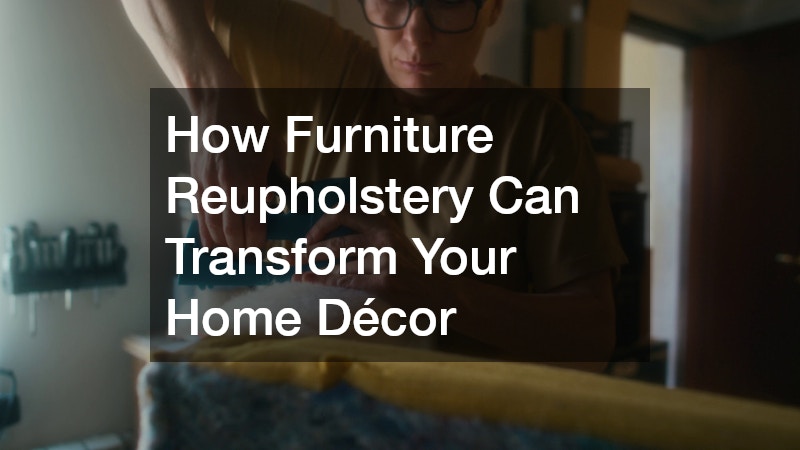Explore the transformative power of furniture reupholstery and how it can revolutionize your home décor, providing a fresh, personalized, and sustainable approach to interior design. By choosing to reupholster, homeowners can breathe new life into their living spaces without the need for significant investment. This method not only revitalizes furniture but also aligns with modern decorating trends focused on sustainability and individualized design aesthetics.
Why Choose Reupholstery Over Buying New Furniture?
Cost-Effectiveness
Understanding the financial savings associated with reupholstering rather than purchasing new pieces is crucial for budget-conscious individuals. Reupholstering can often cost a fraction of buying new furniture, especially when dealing with high-end or custom pieces. This alternative allows homeowners to allocate their savings to other interior upgrades while maintaining or enhancing the quality of their furniture.
The initial expense of quality upholstery fabric and labor is not insignificant, but it is generally lower than the cost of new high-quality furniture. Additionally, reupholstery is an investment that prolongs the lifespan of existing furniture, maximizing the return on original purchase expenditures. These budget-friendly advantages make reupholstering a viable and attractive option for many families.
Sentimental Value
For many individuals, furniture holds more than just functional value; it often carries sentimental importance and cherished memories. Reupholstering these beloved pieces allows homeowners to preserve and protect emotional bonds that may span generations. By opting for reupholstery, families can salvage deeply valued heirlooms while adapting them to modern tastes.
This process respects the original craftsmanship and artistic integrity of vintage or antique furniture, enhancing rather than erasing their historical significance. Updated upholstery can refresh the appearance of such items, ensuring they continue to fit seamlessly into contemporary settings. Additionally, this practice supports the storytelling aspect of home décor, allowing residents to display and share unique familial histories.
Environmental Benefits
Reducing waste and supporting sustainability through the reupholstery process exemplifies an eco-friendly approach to home décor. In a time where environmental responsibility has become paramount, reupholstering furniture minimizes landfill contributions. By choosing reupholstery, consumers contribute to a circular economy, extending furniture life cycles rather than supporting the pervasive disposable culture.
This method also often involves local artisans or businesses, further diminishing the carbon footprint associated with importing new furniture from distant manufacturers. Utilizing existing frames and structures lessens the demand for new materials and resources, effectively reducing the ecological impact of home renovation projects. Thus, prioritizing reupholstery over new purchases aligns personal design choices with broader environmental objectives.
What Should You Consider When Reupholstering Furniture?
Choice of Fabric
Factors to consider when selecting fabric types, colors, and patterns for reupholstery play a critical role in the outcome of your project. It is vital to consider the durability of fabrics, especially for high-use furniture, to ensure longevity and functionality. Color and pattern choices should harmonize with existing interior tones and textures to create a cohesive visual aesthetic.
The selection process should also account for lifestyle needs, such as resistance to stains or ease of cleaning for homes with children or pets. Exploring a wide variety of materials from natural cottons to luxurious velvets can inspire unique and personalized designs. Ultimately, the choice of fabric can significantly impact both the look and practical aspects of reupholstered furniture.
Understanding the Process
Understanding the steps involved in reupholstering furniture, from the removal of the old cover to the final touches, outlines the practical realities of the project. Initial steps include inspecting the furniture structure for repairs, followed by carefully stripping the existing upholstery. This phase requires meticulous attention to maintain structural integrity and secure valuable components like padding and springs.
The choice and preparation of new fabric is next, ensuring accurate measurements and cuts to cover each surface smoothly. Engaging in this methodical process helps anticipate potential challenges and streamline workflow, reinforcing both time management and resource allocation. Adhering to a step-by-step plan enhances the final product, reflecting attention to detail and dedication.
How Does Reupholstery Affect Your Interior Design?
Customization Options
The ability to extensively customize reupholstered furniture allows homeowners to add unique and tailored touches to their home design. This customization fosters the creation of statement pieces that reflect individual style and enhance overall room aesthetics. Reupholstery provides the opportunity to experiment with various textures, materials, and designs to achieve coveted originality.
Homeowners can explore infinite possibilities in fabric choices, from bold prints that add vibrancy to calmer tones for understated elegance. Personal innovation is encouraged, allowing for surprising design outcomes that set a distinct tone. Versatile furniture customization can accommodate seasonal decor changes, flexible enough to evolve with household preferences and trends.
Coordination with Existing Decor
Ensuring that new upholstery fits seamlessly with current décor themes involves careful planning and design consideration. Strategic selection of colors, textures, and designs should complement and enhance existing elements within a room. A harmonious blend of styles can unify various components of a space, elevating overall design cohesion.
Attention to detail ensures that new additions feel like a natural extension rather than an imposition, creating visual balance. Considerations may include matching subtle hues, choosing compatible patterns, or adding contrasting accents for dynamic appeal. The nuance of fabric unification aids the synthesis of new and old elements to achieve an elegant decor narrative.
Furniture reupholstery presents an exceptional opportunity to refresh and personalize your home décor, balancing aesthetics, budget, and environmental considerations, ultimately creating a harmonious and inviting living space. By choosing reupholstery, not only are you investing in the uniqueness and longevity of your furniture, but you are also promoting sustainable practices. This thoughtful approach to home design nurtures both the environment and personal expression, achieving a synthesis of charm, efficiency, and style within the domestic sphere.
.



